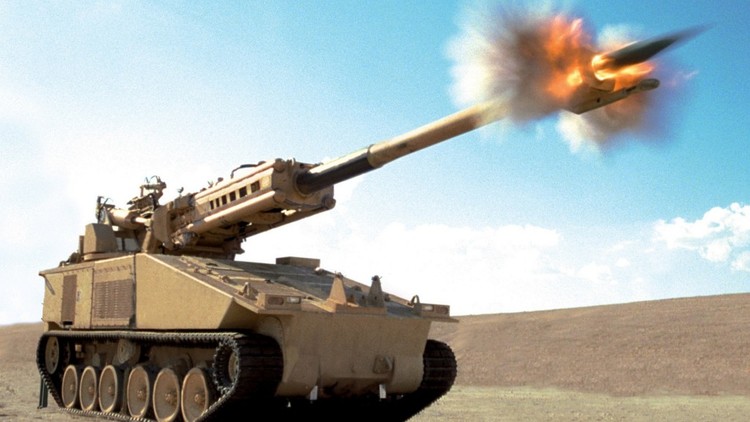Whose side are you on Officer?
 A tank fires a projectile at an angle of
6
0
de
g
with the horizontal to destroy a target. Immediately the Commanding Officer realizes that they have fired at one of their own outposts and orders the crew to fire another projectile at an angle of
4
5
de
g
after some time to destroy the earlier projectile in mid air. After how much time (in seconds) was the second projectile fired?
A tank fires a projectile at an angle of
6
0
de
g
with the horizontal to destroy a target. Immediately the Commanding Officer realizes that they have fired at one of their own outposts and orders the crew to fire another projectile at an angle of
4
5
de
g
after some time to destroy the earlier projectile in mid air. After how much time (in seconds) was the second projectile fired?
Details and Assumptions
- Muzzle velocity of both the projectiles is 1 6 7 0 m / s .
- g = 1 0 m / s 2
- Report your answer to 3 decimal places.
The answer is 71.61.
This section requires Javascript.
You are seeing this because something didn't load right. We suggest you, (a) try
refreshing the page, (b) enabling javascript if it is disabled on your browser and,
finally, (c)
loading the
non-javascript version of this page
. We're sorry about the hassle.
5 solutions
Done same, but got the answer as 70.68 :(
For both the projectiles the y is the same.
So xtan(60) - 0.5gx^2/v^2cos^2(60) = xtan(45) - 0.5gx^2/v^2cos^2(45).
Now solve for x.
t1 = x/vcos(60) and t2 = /vcos(45)
required time is t1 - t2
The parametric equations of the first projectile are: x ( t 1 ) = 8 3 5 t 1 y ( t 1 ) = 8 3 5 3 t 1 − 5 t 1 2
And for the second projectile: x ( t 2 ) = 8 3 5 2 t 2 y ( t 2 ) = 8 3 5 2 t 2 − 5 t 2 2
We need that the coordinates of both projectiles to be the same ( x ( t 1 ) = x ( t 2 ) and y ( t 2 ) = y ( t 2 ) ). So, make the following equation system: 8 3 5 t 1 = 8 3 5 2 t 2 8 3 5 3 t 1 − 5 t 1 2 = 8 3 5 2 t 2 − 5 t 2 2
It's easy to see from the first equation that t 1 = t 2 2 . Replace that value on the second equation and solve: 8 3 5 3 ( t 2 2 ) − 5 ( t 2 2 ) 2 = 8 3 5 2 t 2 − 5 t 2 2 t 2 = 1 6 7 6 − 1 6 7 2
Now, obtain t 1 : t 1 = ( 1 6 7 6 − 1 6 7 2 ) ( 2 ) t 1 = 3 3 4 3 − 3 3 4
And, our answer, by logic, will be t 1 − t 2 , so: t 1 − t 2 = 1 6 7 2 + 3 3 4 3 − 1 6 7 6 − 3 3 4 ≈ 7 1 . 6 1
Given a diagram showing the two projectiles fired at angles
θ
and
ϕ
 Projectile
The first projectile was fired at t = 0 and let us assume that the second projectile was fired at t =
Δ
t time after the first one.
Projectile
The first projectile was fired at t = 0 and let us assume that the second projectile was fired at t =
Δ
t time after the first one.
Since the second projectile must destroy the first one in its path there must be a common point in the trajectories of both projectile
Let us assume that the projectile collide at a point (R,h) in their path. So the point (R,h) must satisfy the equations of projectile.
In Vertical Components
 Vertical component
Where v is the inital velocity of both the projectiles and since the second one is fired after
Δ
t time after its time to reach h will be t -
Δ
t
Vertical component
Where v is the inital velocity of both the projectiles and since the second one is fired after
Δ
t time after its time to reach h will be t -
Δ
t
In Horizontal component
 Horizontal component
Horizontal component
Solving for
Δ
t we get
 Final Expression
Final Expression
Substituting the value of V,
θ
,
ϕ
, and g we get
 Solution
Solution
Horizontal component: V * Cos(60) * t = R = V * Cos(45) * (t - dt) .. t/sqrt(2) = (t - dt).......[I]
dt = (1 - 1/sqrt(2)) * t ..........[II]
Vertical Components:
V * Sin(60) * t - (1/2) * 10 * t^2 ..=.. V * Sin(45) * (t - dt) - (1/2) * 10 * (t - dt)^2 ....[III]
Substituting [I] in [III] and trig values and V, and simplifying, t = 244.50
Using [II] to get dt = (1 - 1/sqrt(2)) * 244.50 = 71.61s. Just simplification in calculations !!!
Note. This problem is very, very far from reality because .... lacks air. :)
Solve the simultaneous equations:
1 6 7 0 cos ( 6 0 ) t = 1 6 7 0 cos ( 4 5 ) ( t − t ′ ) 1 6 7 0 sin ( 6 0 ) t − 2 1 g t 2 = 1 6 7 0 sin ( 4 5 ) ( t − t ′ ) − 2 1 g ( t − t ′ )